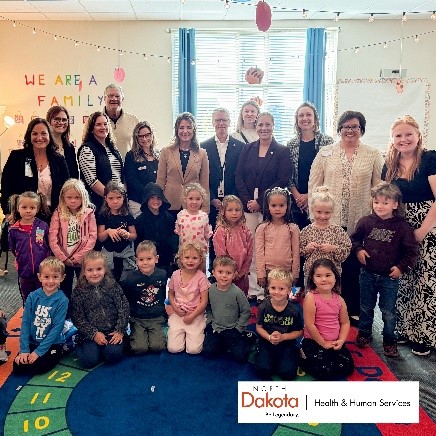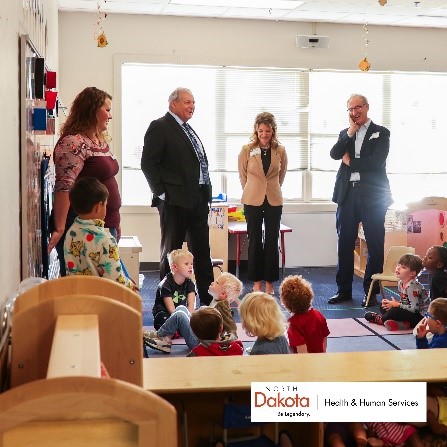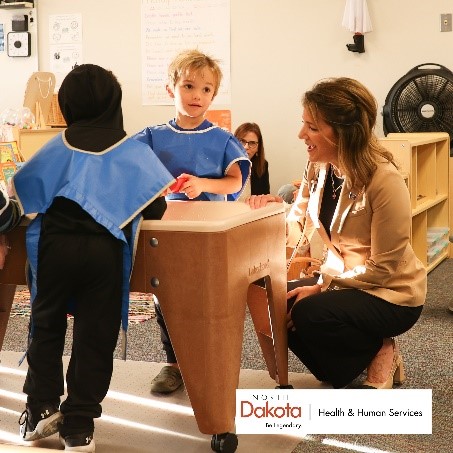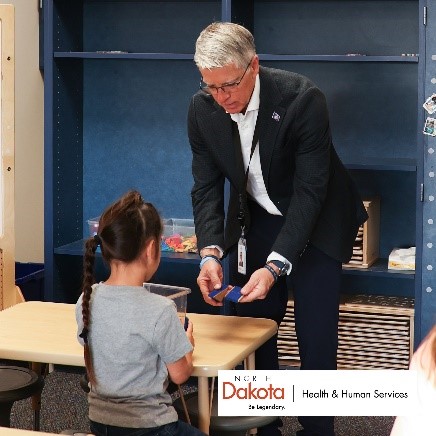Lt. Gov. Michelle Strinden, state legislators and representatives from North Dakota Health and Human Services (HHS) recently visited Best in Class early childhood programs to celebrate the initiative’s five-year milestone and see firsthand how high-quality early learning experiences are preparing children for kindergarten and beyond.
The delegation toured Best in Class sites in West Fargo, Mapleton, Tower City and Valley City. During the visits, they met with educators, observed classroom activities and heard directly from program leaders about how Best in Class supports quality early learning during the year before kindergarten.
Impressive gains in literacy and math
Children enrolled in Best in Class demonstrated remarkable growth across all areas of development during the 2024-25 school year.
- Literacy: Seventy-nine percent of children met or exceeded literacy standards in fall 2024. By spring, that number rose to 96%, with 22% exceeding expectations.
- Math: Sixty percent met expectations in the fall, with none exceeding. By spring, 93% met or exceeded expectations, including 23% who exceeded.
Students also showed strong progress in life skills, physical development, language and cognitive skills, underscoring the lasting impact of high-quality early learning environments.
“Today we had an incredible opportunity to visit multiple Best in Class locations along the I-94 corridor. What we witnessed were quality environments, incredible educators and engaged children,” Strinden said. “The Best in Class investment is one that needs to continue as we strive to expand high-quality early childhood experiences across our great state.”
A growing investment in young learners
Launched during the 2021-22 program year, Best in Class began with 24 programs, 28 classrooms and 371 children. Today, it has expanded to 64 programs, 94 classrooms and 1,239 children statewide — a 260% increase in five years.
This growth is supported by increased legislative funding to expand access to quality early learning. Lawmakers approved additional funding for the 2025-26 program year to support new classrooms and sustain coaching, professional development and quality improvements statewide.
Through Best in Class, programs receive funding, professional coaching and ongoing support to strengthen classroom environments, teaching practices and family engagement. Award amounts for the 2025-26 program year range from $15,000 to $120,000 per classroom, depending on the number of children served and total operating hours.
“When we invest in those who care for children, we foster connection, resilience and hope in their earliest years, instilling healthy practices in North Dakota’s future leaders,” said HHS Commissioner Pat Traynor. “High-quality, play-based learning experiences help children build essential social, emotional and cognitive skills, ensuring they are ready to thrive in kindergarten and beyond.”
Quality in action
Best in Class is grounded in more than 25 years of research showing that high-quality early childhood experiences have long-term benefits for children’s development and future success.
Participating classrooms use play-based curriculum, authentic observation methods and individualized learning strategies to support growth across all developmental domains.
During the tour, educators shared how the program emphasizes nurturing the whole child by integrating health screenings, play-based learning and intentional kindergarten transition activities to support each child’s growth and development.
Looking ahead
Best in Class remains a cornerstone of North Dakota’s early childhood strategy, supporting programs that provide at least 400 hours of high-quality learning over a 32-week period. The state’s continued investment ensures more families can access meaningful early learning opportunities close to home.




